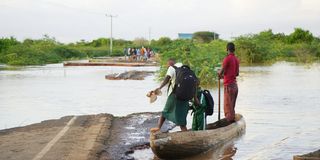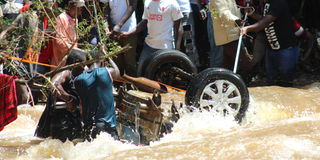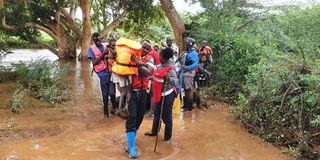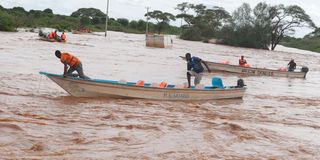Premium
Floods expose gaps in disaster preparedness

Houses built on riparian land in Mathare, along the Nairobi River, were demolished on May 7. The government gave the order following devastating floods in the area.
What you need to know:
- The scars of these disastrous floods are etched deep across the landscape.
- More than 58 roads have also been destroyed, including key highways.
The Kenya Meteorological Department (KMD) has released its latest five-day forecast, predicting continued rainfall in some parts of the country.
Areas in the highlands east and west of the Rift Valley and the Lake Victoria Basin (Siaya, Kisumu, Homa Bay, Migori, Kisii, Nyamira, Trans Nzoia, Baringo, Uasin Gishu, Elgeyo-Marakwet, Nandi, Nakuru, Narok, Kericho, Bomet, Kakamega, Vihiga, Bungoma, Busia and West Pokot counties) will receive rain, with a chance of isolated heavy downpours in these regions.
Rainfall was also likely in the north-western region starting from yesterday, with some areas potentially experiencing heavy showers. Residents in Kajiado, Machakos and a few areas at the Coast could expect occasional rain as well.
Hot weather will persist across parts of the country, with highs of 37 degrees Celsius in the north-eastern region. And a significant temperature drop is expected at night.
In the highlands east of the Rift Valley (including Nairobi County) and surrounding areas (Nyandarua, Laikipia, Nyeri, Kirinyaga, Murang’a, Kiambu, Meru, Embu and Tharaka-Nithi temperatures could dip to as low as eight degrees Celsius.
Stay hydrated
Health officials have recommended that people stay hydrated and cool during the day, but they should wear extra clothes and have extra bedding for chilly nights.
Kenya Met said that sunny and dry conditions will dominate many parts of the country, and this may offer temporary respite for scores of people who have been battered by relentless rain.
The struggle for normalcy is particularly evident in Mathare North in Nairobi County which was badly affected by flooding. Residents could be seen sifting through the rubble on Saturday morning after their houses were flattened.
Following a government order, structures built within 30 metres of riparian areas (rivers and streams) were demolished.

Residents of Mathare pictured next to a building built on riparian land in Mathare, along Nairobi River on May 7, 2024
Some of the affected families received welfare support while others voluntarily moved to safer areas. The emotional toll is evident. Frustration and despair hang heavy in the air.
Can polite conversation bridge the chasm of loss that separates us? Everywhere you look, there is loss.
The devastating floods left more than 250 people dead, scores missing and at least 40,000 households displaced. The scars of these disastrous floods are etched deep across the landscape. Homes lie in ruins, crops were washed away, and entire communities are struggling to rebuild their lives.
More than 58 roads have been destroyed, including key highways such as the Nakuru-Eldoret road, a vital transport link connecting Kenya to Uganda, Rwanda, and the Democratic Republic of Congo.
Destruction of infrastructure
“The destruction of infrastructure will have a major economic impact. Assessments from the last major flooding in 2018 show the government allocated an extra Sh15.6 billion (24 percent of the budget in the previous year) for repairs and maintenance of road infrastructure,” says Timothy Njeru, a research fellow at Egerton University, in an article published in The Conversation.
Acknowledging the damage, Roads, Transport and Public Works Cabinet Secretary Kipchumba Murkomen has said that the ministry requires up to Sh30 billion to rehabilitate critical infrastructure.

Students disembark from a canoe to school at Watta Hamesa village, Tana River County on Monday May 13.
Farmers also bore the brunt of the floods, with an estimated 40,000 acres (16,187 hectares) of produce destroyed, which is double the amount affected by the 2018 floods (20,000 acres), according to Mr Njeru, who is also a development economist.
“The flooding of 2,000 acres of the Mwea Irrigation Scheme, for instance, is likely to result in losses to the tune of Sh60 million (about US$445,000) in lost crop,” he said.
To understand how we got here, you have to go back to the climate happenings and failures of last year.
East Africa, which is located near the Equator, experiences both wet and dry seasons. The long rainy season, critical for farmers, typically occurs from March to May. A shorter rainy season is expected between October and December. Last year had extremes and record temperatures—the hottest year on record. During the long rainy season, the country received significantly less rain than usual due to La Nina, a weather pattern associated with cooler ocean temperatures in the Pacific. This led to widespread drought and crop failures in East Africa.
Indian Ocean Dipole
According to World Weather Attribution (WWA), the climate of East Africa is affected by natural phenomena such as the El-Niño and the Indian Ocean Dipole (IOD). The IOD is a climate pattern where the temperature of the ocean water varies between the eastern and western parts of the Indian Ocean. It has three phases; positive, negative and neutral. A positive phase leads to more rain in East Africa, while a negative phase brings the opposite effect, with no major changes during the neutral phase.
In July last year, the WWA predicted that the region would experience El-Nino — a phenomenon characterised by warmer Pacific Ocean temperatures and typically bringing more rain than usual to East Africa. This prediction was supported by the Intergovernmental Authority on Development’s Climate Prediction Centre (ICPAC) and Kenya Met.
It was here that confusion started. On October 22, 2023 while attending a Church service in Dagoretti, Nairobi, President William Ruto downplayed the potential impact of El-Nino, suggesting that farmers were prepared for heavy rainfall.
This statement, along with a general distrust of weather forecasts by some Kenyans, may have contributed to the scepticism as many

Divers from Bomet County Disaster Management unit struggling to retrieve bodies from a vehicle that plunged into Nyangores River on the Silibwet-Merigi highway in Bomet central constituency on May 9, 2024. Three people are confirmed dead in the accident and a child is missing.
were caught flat-footed.
The meteorologists at KMD reiterated the presence of El-Nino-induced heavy rains, which later materialised. The result was devastating— over 130 deaths, countless homes destroyed, and crops washed away.
While the El-Nino warnings preceded the disaster, there was another crucial prediction for the long rainy season (March-May) issued by the Ministry of Environment in late February this year. This forecast, just days after a similar warning by ICPAC, also anticipated “wetter than normal conditions” and potential flooding.
“Sea surface temperatures determine seasonal weather so even in terms of making forecasts, we depend on sea surface temperatures a lot, how they vary, movements and so on. And we work with the IOD signal. When that is positive, and it also matches a situation where the El-Nino signal is also positive, there is no doubt that we will have El- Nino-influenced rainfall. And that is what happened last year, the short-range season, and come the long-range season, we have had a situation where the signal of El-Nino is still strong. Though currently, it is waning. So, by the end of the season, we expect that it will be very weak. Again, the signal doesn’t have a standard time because it is a phenomenon that mainly affects the short rainfall season in this area. But to have it going on into the long rainy season, is not a very common thing,” explains Director of Kenya Met Dr David Gikungu.
Warmer atmosphere
Clair Barnes, researcher at Grantham Institute - Climate Change and the Environment, Imperial College London said: “Climate change likely increased the intensity of the extreme rainfall that recently hit East Africa.”
Rainfall is increasing in many parts of the world because a warmer atmosphere can hold more moisture, leading to heavier downpours.

A man and his children, displaced by floods in Garissa County, take shelter from the scorching sun in a makeshift shelter amid the threat of the raging Tana River, which has flooded the estates along its banks in the town.
WWA has started a study to determine precisely how much heavier the rainfall in Kenya and Tanzania was due to climate change. The findings will be published late next week.
The long rain season forecast report, obtained by the Nation, showed the potential consequences, including floods and flash floods in areas prone to such disasters.
The report says: “Floods and flash floods are likely over several parts of the country, especially over the Coast, south-eastern lowlands, the Lake Victoria Basin, parts of the central and South Rift Valley, northeast, and north-western parts of the country and urban centres with poor drainage systems. This could lead to destruction of property, loss of lives, displacement of people and damage of critical infrastructure, resulting in limited access to essential goods and services.”
The report went further to give advisories to the health, transport, water, energy, the environment and forestry officials as well as the media.

Kenya Red Cross officials evacuate families marooned by floods in Longewan village in Baringo South on May 4, 2024.
But that’s just half of the story; the other part is riddled with questions and few answers.
Concerns are mounting about the government’s handling of the early warnings and preparedness for the long rains’ impact.
The Law Society of Kenya (LSK) and the Kenya Human Rights Commission (KHRC) have filed separate lawsuits, echoing the concerns of ordinary Kenyans on social media.

Boats in the flooded Modogo area in Tana River County on May 10, 2024.
“We felt there was a lot of laxity with regards to response and yet there has been a lot of loss of life. We want to hold the government accountable for the loss of lives, destruction of property, and potential misuse of funds allocated for disaster preparedness,” offers Faith Odhiambo, LSK president.
Dr Guleid Artan, Director of ICPAC, stressed the urgency of climate-proofing the region through investments in resilience and mitigation efforts.
Proactive strategies
During Nation’s X Spaces held on May 9, experts called for proactive strategies to address future floods. Dr Ahmed Idris, Director General of the Kenya Red Cross, emphasised the need for early action based on weather forecasts.
“We can’t reduce rainfall,” he said, “but we can change how we interact with it.” He highlighted the importance of responsible urban planning and long-term environmental solutions.
At a news briefing, CS Soipan Tuya acknowledged the extraordinary nature of the recent weather events.
-Additional reporting by David Mwere





